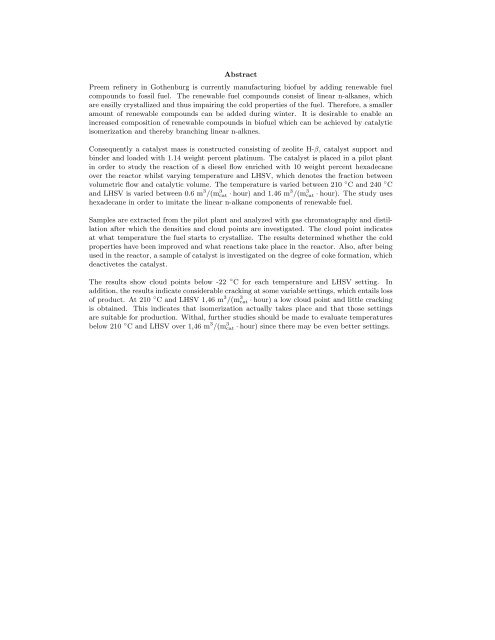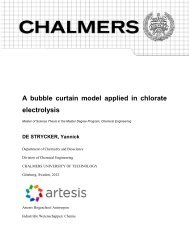Zeolit Pt/H-β som isomeriseringskatalysator för biodiesel - Chalmers ...
Zeolit Pt/H-β som isomeriseringskatalysator för biodiesel - Chalmers ...
Zeolit Pt/H-β som isomeriseringskatalysator för biodiesel - Chalmers ...
Create successful ePaper yourself
Turn your PDF publications into a flip-book with our unique Google optimized e-Paper software.
Abstract<br />
Preem refinery in Gothenburg is currently manufacturing biofuel by adding renewable fuel<br />
compounds to fossil fuel. The renewable fuel compounds consist of linear n-alkanes, which<br />
are easilly crystallized and thus impairing the cold properties of the fuel. Therefore, a smaller<br />
amount of renewable compounds can be added during winter. It is desirable to enable an<br />
increased composition of renewable compounds in biofuel which can be achieved by catalytic<br />
i<strong>som</strong>erization and thereby branching linear n-alknes.<br />
Consequently a catalyst mass is constructed consisting of zeolite H-<strong>β</strong>, catalyst support and<br />
binder and loaded with 1.14 weight percent platinum. The catalyst is placed in a pilot plant<br />
in order to study the reaction of a diesel flow enriched with 10 weight percent hexadecane<br />
over the reactor whilst varying temperature and LHSV, which denotes the fraction between<br />
volumetric flow and catalytic volume. The temperature is varied between 210 ◦ C and 240 ◦ C<br />
and LHSV is varied between 0.6 m 3 /(m 3 cat · hour) and 1.46 m 3 /(m 3 cat · hour). The study uses<br />
hexadecane in order to imitate the linear n-alkane components of renewable fuel.<br />
Samples are extracted from the pilot plant and analyzed with gas chromatography and distillation<br />
after which the densities and cloud points are investigated. The cloud point indicates<br />
at what temperature the fuel starts to crystallize. The results determined whether the cold<br />
properties have been improved and what reactions take place in the reactor. Also, after being<br />
used in the reactor, a sample of catalyst is investigated on the degree of coke formation, which<br />
deactivetes the catalyst.<br />
The results show cloud points below -22 ◦ C for each temperature and LHSV setting. In<br />
addition, the results indicate considerable cracking at <strong>som</strong>e variable settings, which entails loss<br />
of product. At 210 ◦ C and LHSV 1,46 m 3 /(m 3 cat · hour) a low cloud point and little cracking<br />
is obtained. This indicates that i<strong>som</strong>erization actually takes place and that those settings<br />
are suitable for production. Withal, further studies should be made to evaluate temperatures<br />
below 210 ◦ C and LHSV over 1,46 m 3 /(m 3 cat · hour) since there may be even better settings.















